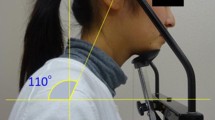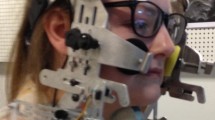Summary
The tongue is a complex muscular structure. Apart from its intrinsic strength, it has a major influence on the adjacent bony structures. Real time ultrasound appears to be the method of choice for assessing the topographic and functional anatomy. The examination was performed using an Acuson 128 scanner, with a 5 MHz probe, either a sector scanner (sagittal plane) or linear array probe (coronal plane). The scans were performed using the sub-hyoid approach, between the rami of the mandible. The images were stored on U-matic videotape. Thirty adult patients were included in the study population. The scan protocol consisted of an examination of the tongue at rest, a scan of the swallowing mechanism with and without a liquid bolus and a study of the posterior lingual positions (which show some anatomical variation). The intrinsic muscles of the tongue and the floor of the mouth could be identified on the “at rest” images. The lingual mass is the most important parameter and is opposed against the palate in order to propel a bolus during the swallowing mechanism. The mobility, shape and supporting structures of the tongue are variable depending on the nature of the bolus, the patient and the two imaging planes. Ultrasound is a simple and non-invasive method for the examination of the buccal cavity. The function of the posterior portion of the tongue must be taken into consideration prior to any treatment concerning the oral cavity.
Résumé
La langue est un ensemble musculaire complexe. De part son pouvoir morphogénétique, elle joue un rôle important sur les pièces osseuses l'environnant. L'échographie en temps réel nous a paru être le moyen de choix pour l'appréhender sur le plan topographique et fonctionnel. Cette étude a été effectuée à l'aide d'un échographe type Acuson 128 ; les sondes ont une fréquence de 5 mHz ; elles sont sectorielles (plan sagittal) ou linéaires (plan frontal). Elles sont placées dans la région sous-hyoïdienne, entre les deux branches horizontales de la mandibule. Les images sont stockées sur magnétoscope U-Matic. La population est constituée de 30 adultes. Le protocole est le suivant : examen de la langue au repos, puis en fonction : déglutition “à vide”, et, de substance liquide. L'analyse des images lors de la position de repos nous a permis de reconnaître les muscles de la langue et du plancher de la bouche, et d'apprécier la posture linguale (qui change selon les individus). Au cours de la déglutition : les muscles du plancher de la bouche et de la langue se déforment. La masse linguale est l'élément le plus intéressant à observer : elle se place contre le palais dur pour propulser le bol vers l'arrière. La mobilité, la forme, les appuis linguaux sont variables selon la nature du bol, selon les patients, et ce dans les deux sens de l'espace. L'examen échographique nous renseigne de façon simple et non invasive sur “ce qui se passe” dans la cavité buccale. La langue, de part sa posture, son activité au cours de la fonction est un élément important dont il faut tenir compte avant, ou pendant toute thérapeutique visant à restaurer la cavité orale.
Similar content being viewed by others
References
Azerad J (1991) Deglutition in Physiologie de la manducation. Masson, Paris, pp 37–53
Beck TJ, Gayler BW (1990) Image quality and radiation levels in videofluoroscopy for swallowing studies: A review. Dysphagia 5 : 118–128
Carpentier P, Pajoni D (1989) La langue, un ensemble musculaire complexe. Rev Orthop Dento-Faciale 23: 19–28
Christianson R, Lufkin R, Hanafee W (1987) Normal magnetic resonance imaging anatomy of the tongue, oropharynx, and larynx. Dysphagia 1: 119–127
Cleall JF (1905) Deglutition: a study of form and function. Am J Orthod 51: 566–594
Doty RW, Bosma JF (1956) An electromyographic analysis of reflex deglutition. J Neurophysiol 19: 44–60
Fink A (1986) The tongue, the lingometer, and the role of accommodation in occlusion. Angle Orthod 56: 225–233
Fontenelle A, Woda A (1975) La déglutition in Orthopédie Dento-Faciale, bases fondamentales. Julien Prélat, Paris, pp 266–285
Gritzmann N, Fruhwald F (1988) Sonographic anatomy of the tongue and floor of the mouth. Dysphagia 2: 196–202
Hamlet S (1989) Dynamic aspects of lingual propulsive activity in swallowing. Dysphagia 4: 136–145
Hamlet SL, Stone M, Shawker TH (1988) Posterior tongue grooving in deglutition and speech: preliminary observations. Dysphagia 3: 65–68
Mac Kenna K, Bradley AJ, Lufkin RB, Hanafee WN (1990) Magnetic resonance imaging of the tongue and oropharynx. Top Magn Reson Imaging 2: 49–59
Petit H, Davis W (1986) The role of the tongue in facial development. The journals of Pedodontics 10: 199–210
Ramsay CH (1955) Cinéfluorographic analysis of the mechanism of swallowing. Radiology 64: 498–518
Savary M, Dubreuil Ch, Havry JA (1983) Physiologie des voies aérodigestives supérieures. Masson, Paris, pp 203–224
Shawker TH, Sonies BC, Stone M (1984) Soft tissue anatomy of the tongue and floor of the mouth: an ultrasound demonstration. Brain Lang 21: 335–350
Shawker TH, Sonies BC, Stone M, Baum BJ (1983) Real-time ultrasound visualization of tongue movement during swallowing. J Clin Ultrasound 11: 485–490
Sonies BC, Parent LJ, Morrish K, Baum BJ (1988) Durational aspects of the oral-pharyngeal phase of swallow in normal adults. Dysphagia 3: 1–10
Stone M, Shawker TH (1986) An ultrasound examination of tongue movement during swallowing. Dysphagia 1: 78–83
Watkin KL, Zagzebski JA (1973) On line ultrasonic technique for monitoring tongue displacements. J Acoust Soc Am 54: 544–547
Wein BB, Drobnitsky M, Klajman S, Angerstein W (1991) Evaluation of functional positions of tongue and soft palate with MR Imaging: initial clinical results. JMRI 1: 381–383
Zuniga-Caballero A, Gaspard M, Gasc JP (1990) Nouveau protocole d'étude radiocinématographique de la déglutition extraprandiale chez l'enfant. Rev Orthop Dento Faciale 24: 281–290
Author information
Authors and Affiliations
Rights and permissions
About this article
Cite this article
Maniere-Ezvan, A., Duval, JM. & Darnault, P. Ultrasonic assessment of the anatomy and function of the tongue. Surg Radiol Anat 15, 55–61 (1993). https://doi.org/10.1007/BF01629863
Received:
Accepted:
Issue Date:
DOI: https://doi.org/10.1007/BF01629863




